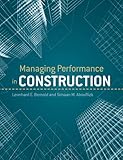| Title: | Managing Performance in Construction |
| Categories: | Construction |
| Authors: | Leonhard E. Bernold, Simaan M. AbouRizk |
| ISBN-10(13): | 0470171642 |
| Publisher: | John Wiley & Sons |
| Publication date: | 2010-07-20 |
| Number of pages: | 528 |
| Language: | English |
| Picture: |

|
| Review: |
The authors of this interesting book have set out to improve the performance of the construction industry. This has been the aims of many and there have been several eras that we have lived through, for example we were encouraged to look at construction as part of the manufacturing industry and learn from manufacturing. Whilst that brought some benefits the construction industry has its own unique characteristics and the drive for improved performance has to be focused on the construction industry itself. This book adopts that philosophy and it recognises that other sectors are adopting streamlined methodologies and technologies in their drive for improvement so must our industry. This book presents state-of-the-art management concepts in operational planning and control, performance measurements, skills in safety training that does improve productivity. Included are Building Information Modelling, sustainability, e-construction management and human issues such as motivation, leadership and the skills needed to address production challenges. The book is very focused on learning and contains access web based software that provides simulation modelling software with learning exercises. The content of the book is as follows: - Indicators of an Industry in Transition - Productivity - Efficient Site Operations - Simulation and its use in Modelling Production Systems - Simulating Tunnel Construction - Competencies to Drive the Company - Health and safety and Productivity - Human Motivation - Performance of Leaders and Teams - Communication - Performance Management The two authors are academic from Hanyang University, South Korea and the University of Alberta, Canada and bring a wide range of experience to this text. They intend it to be student focussed and to engage students at several different levels. I think that the authors emphasis on the benefits to students underplays the benefits that practising professional would get from this book. It is a challenging text that will make readers pause and think. Inevitably each person forms their own relationship with a book and for me the aspect that attracted me to this text was the use of simulation to support teaching and the example that the authors presented. The example was the simulation modelling of tunnel construction. Now it so happens that my first job was on a small diameter tunnelling project. I had all the excitement of being in a new working environment, meeting new people and learning about new (then) technology. My duty was setting out the tunnels which in those days was no easy task but our biggest problem was productivity and the simulation modelling that these authors present would have been our solution, but it has arrived 40 years too late. The use of simulation in teaching has been a feature of my colleagues and my teaching for an exceptionally long time. The best example we could give would be our well established construction company simulation www.MERITgame.com which has been in use with companies and students for over 20 years and introduces company, business and financial management. Our experience is that simulation presents a great stimulus to self learning and is a learning vehicle that inspires and excites students. Teaching stimulated and excited students in a febrile atmosphere can only be described as a great joy and one that tests the teacher. Few other teaching vehicles have the same impact. In house company courses are just as exciting as this is a learning mode that suits the more experienced professionals. I liked this book, I resonated with its approach of driving performance improvement through improving the management techniques as well developing the human contribution, I emphasised with the learning style it promotes and I'm sure that many will find it of great value. Ronald McCaffer September 2011 |



